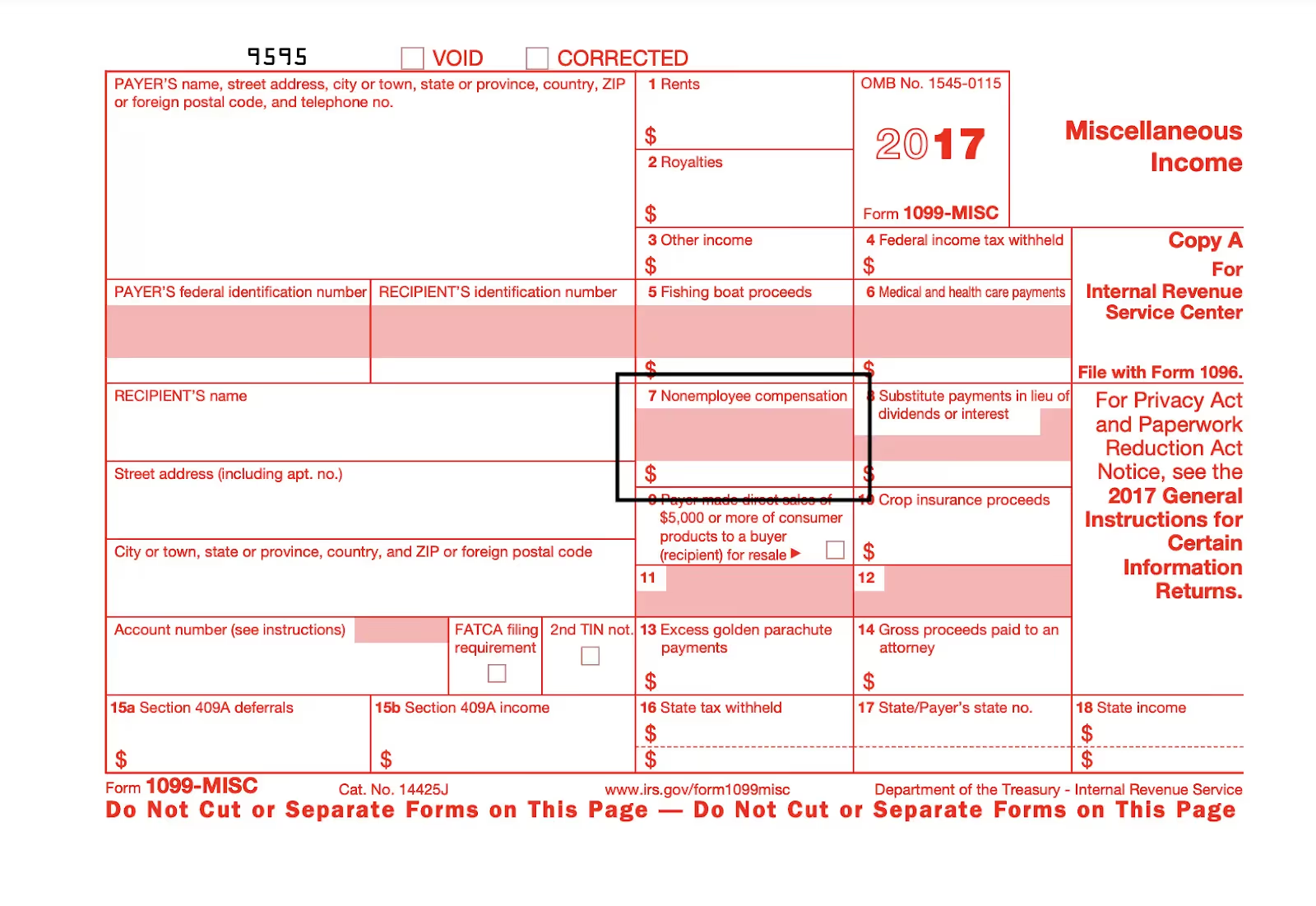Do you know that as a company, if you fail to issue a form 1099-NEC or 1099-MISC by January 31 and March 1, respectively, you may be penalized from $60 to $310 per form in a tax year, depending on how long past the deadline you issue the form.
In tax reporting, these forms, the 1099-MISC and the 1099-NEC, play crucial roles in documenting income and payments to non-employees. These forms are essential to the Internal Revenue Service's (IRS) reporting system. Therefore, it is essential to have a deep understanding of them and the distinctions between the two.
This blog will help you explore the key differentiations between the 1099-MISC and 1099-NEC forms, their unique functions, reporting requirements, and implications for businesses and recipients.
Background on 1099 Forms
Prior to exploring the differences between 1099-MISC vs. 1099-NEC, it's essential to understand the bigger context of 1099 forms. These forms are used to report various incomes other than regular employment, such as dividends, interest, self-employment income, and rental income. These forms aim to ensure that the IRS is aware of all income generated by taxpayers—not just money from traditional employment.
The 1099-MISC form covers miscellaneous income from multiple sources. On the other hand, the 1099-NEC, introduced in 2020, specifically focuses on non-employee compensation. Both forms require accurate reporting by the payer to the IRS and the recipient. It helps to improve transparency in income documentation beyond typical employment earnings.
Who Uses these forms?
Both the 1099-MISC and the 1099-NEC forms serve distinct purposes and are utilized by various entities for reporting specific types of income. The 1099-MISC form is employed to document miscellaneous income sourced from various channels, encompassing rents, royalties, prizes, and other payments that do not fall under standard employment categories. On the other hand, the 1099-NEC, introduced in 2020, specifically focuses on non-employee compensation. This includes payments made by companies to freelancers, independent contractors, consultants, and other self-employed individuals for services rendered. Both forms play a crucial role in ensuring accurate income documentation, enhancing transparency in financial reporting. Payers are obligated to report these earnings accurately to the Internal Revenue Service (IRS) and provide recipients with the necessary information for their individual tax returns.
What is 1099-MISC?
The 1099-MISC form is a tax form meant to report additional earnings of more than $600 that are not included in pay. Prior to 2020, form 1099-MISC was used to report contractor or sole proprietor income. Currently, it is solely used to report other payments. As per the current norm of the IRS, companies or individuals must use form 1099-MISc to report payments for the following:
- Rent payments
- Prizes and awards
- Attorney payments
- Royalties
- Medical and health care payments
- Crop insurance proceeds
- Any fishing boat proceeds
- Money received from fishing
- Broker fees or royalties associated with dividend distribution or tax-exempt interest payments of $10 or more
- Profits from the direct sale of consumer goods meant for resale that are more than $5,000
Key Features of 1099-MISC:
1. Diverse Income Categories:
The 1099-MISC form was a flexible equipment for reporting different payment scenarios because it included a wide range of income types.
2. Box 7 for Non-employee Compensation:
Before introducing the 1099-NEC, Box 7 on the 1099-MISC was used to report non-employee compensation. This included payments to independent contractors and freelancers.

Fig: 2017 Form 1099-MISC
With the introduction of the 1099-NEC, Box 7 on the 1099-MISC is no longer used to report non-employee compensation. Now, this box is revised to report direct sales of at least $5,000.

Fig: 2022 1099 Form
3. Miscellaneous Income:
This tax form is meant for miscellaneous income, such as rent, royalties, prizes, and other types of income that do not fit into standard employment categories.
Introduction of 1099-NEC
The introduction of the 1099-NEC marked a significant shift in tax reporting. Form 1099-NEC is a tax form used by companies in the United States of America to report payments above $600 to contractors, consultants, freelancers, and other self-employed people who perform services for those companies but aren’t working as permanent staff of the organization.
In 2020, The Tax Cuts and Jobs Act (TCJA) introduced some significant changes to tax regulations by creating the 1099-NEC regarding the reporting of income taxes. The key purpose of this new form was to separate non-employee compensation from the 1099-MISC. This form provides a transparent and more specific reporting structure.
Key Features of 1099-NEC
1. Non-Employee Compensation:
This form is introduced to report nonemployment compensation payments of $600 or more. An employer needs to submit a 1099-NEC form of any independent contractors or businesses to whom they paid $600 or more as fees, commissions, prizes, awards, or other forms of compensation for their services.
2. Elimination of Box 7 on 1099-MISC:
Before 2020, Box 7 on the 1099-MISC was used for reporting non-employee compensation but is no longer applicable.
What are the differences between 1099-MISC and 1099-NEC?
Here are the significant differences between 1099-MISC and 1099-NEC:
1. Type of Income Reported:
Traditionally, 1099-MISC is used to report various types of miscellaneous income, including rents, royalties, prizes, and other types of payments.
On the other hand, 1099-NEC is used for reporting non-employee compensation, such as payments made to freelancers, independent contractors, consultants, and other self-employed individuals.
2. Timeline:
Previously, 1099-MISC was used for non-employee compensation too, but as of 2020, this category was moved to 1099-NEC.
Meanwhile, 1099-NEC was introduced specifically for reporting non-employee compensation.
3. Form Structure:
1099-MISC contains multiple boxes for various types of income, leading to potential confusion regarding where to report non-employee compensation.
On the other hand, 1099-NEC has streamlined the process for reporting non-employee compensation in Box 1.
Table 1: Comparison of 1099-MISC and 1099-NEC
Choosing Between forms 1099-MISC and 1099-NEC
The 1099-MISC or 1099-NEC, which form is appropriate to report tax, depends on the nature of payments made and the type of income reported. The following guidelines can help you to select which form to use:
1. Non-Employee Compensation:
When paying freelancers, independent contractors, or service providers for their services, you must use the form 1099-NEC. It is exclusively designed to report non-employee compensation.
2. Miscellaneous Income:
If your payments fall into categories like rent, royalties, or other miscellaneous income and are unrelated to non-employee compensation, you should use the form 1099-MISC to report.
3. Direct Sales:
When the payment is for direct sales of at least $5,000, you must choose 1099-MISC and use box 7 to report the same.
Table 2: Reporting Requirements and Deadlines For Form 1099-MISC
Reporting Requirements and Deadlines
It is important to be aware of reporting requirements and deadlines of forms 1099-MISC vs. 1099-NEC for companies to ensure compliance with IRS regulations and avoid potential penalties.
Reporting Requirements and Deadlines for Form 1099-MISC
You must file a 1099-MISC if your company paid an individual or LLC at least $600 in rent, prizes, awards, medical and healthcare payments, and payments to an attorney during the year.
Copies of Form 1099-MISC:
There are two copies of the form.
1. Copy A or filling copy: This copy is filed with the IRS, reporting the non-employee compensation payments.
2. Copy B or recipient copy: This copy is provided to the recipient of the non-employee compensation by January 31. It serves as a record for the recipient to include in their individual tax return.
Deadlines:
1. Filing with the IRS: The IRS states that the deadline for filing 1099 MISC forms on paper is February 28. The deadline is March 31st if you plan to submit your 1099 MISC forms electronically.
2. Providing Copies to Recipients: Copy B of Form 1099-MISC must be provided to the recipient by January 31.
Reporting Requirements and Deadlines for Form 1099-NEC
When you hire freelancers or contractors and pay $600 or more for their services in a calendar year, you must report those earnings by filing Form 1099-NEC. Here are key aspects of the reporting process:
Copies of Form 1099-NEC:
Again, there are two copies of the form.
1. Copy A: This copy needs to be filed with the IRS.
2. Copy B: This copy needs to be sent directly to the contractor. No further action is needed from the contractors’ end; it is essential for their records.
State Requirements:
While most states of the United States of America mandate filing 1099-NEC and 1099-MISC forms, 11 states ( Alaska, Florida, Illinois, Nevada, New Hampshire, New York, South Dakota, Tennessee, Texas, Washington, and Wyoming) are exempt from 1099 filing.
To file a form 1099-NEC, first, you need a W-9 form from your contractor containing necessary details like the contractor’s name or business name, business entity, present address, and taxpayer identification number (SSN, ITIN, or EIN). You must use this information to complete the 1099-NEC and verify payment totals.
Deadlines:
Copy A: You must send this copy to the IRS by January 31. You can either mail the form or file it electronically. If you mail the form, you have to use form 1099 as a cover sheet; duly fill both the forms and send them.
To electronically file the form using the IRS’ FIRE System, you need compatible software and a Transmitter Control Code (TCC). You can get access by submitting Form 4419 at least 30 days before the deadline.
Copy B: You can send this copy to your contractors physically or electronically with their consent by January 31.
Table 3: Reporting Requirements and Deadlines For Form 1099-NEC
Implications for Businesses and Recipients
Understanding the differences between 1099-MISC and 1099-NEC is essential for both businesses and recipients. Using the correct form is essential for organizations to ensure compliance with IRS regulations. It helps to reduce the risk of penalties. On the other hand, accurately reporting income is vital for fulfilling recipients’ tax obligations.
If an organization fails to fill up and submit the right form, it may face penalties for incorrect filing. The IRS has clear guidelines for each type of 1099 form. It is the responsibility of companies to familiarize themselves with the rules to avoid potential issues. Recipients, on the other hand, must accurately report all income received, whether through the 1099-MISC or 1099-NEC, to avoid discrepancies with the IRS.
You can also take the help of Gloroots to pay international contractors and fill out the correct tax forms. Gloroots can make your contractor management much easier by helping you with everything from identifying and sending the right tax forms to keeping track of the workers’ rates and the amount of time they earned working for you—everything in one comprehensive, simple-to-use platform.
1099 NEC penalties vs. 1099 MISC penalties
In case of missing deadlines or incorrect payment reporting, the IRS charges equal penalties for both forms.
Missing deadline:
As per the latest 2023 mandate, the IRS charges from $50 to $290 per form on missing the tax filing deadline. In case of missing the deadline, the amount of penalties (per form) will be:
- $50, if you file it within 30 days
- $100, if you file the form more than 30 days late but before August 1
- $260, if you file on or after August 1
And, if the IRS finds you deliberately ignore the deadline, the penalty goes up.
Table 4: Penalties for Missing Deadlines or Underreporting
Underreporting Income:
It is important to maintain an all-inclusive report of the amount paid to your contractors to avoid underreporting income. In case of accidental or intentional underreporting, the IRS will charge an additional 20% of the underpayment.
The way forward
The introduction of the 1099-NEC brought about a significant change in the landscape of tax reporting. It separates non-employee compensation from the broader categories covered by the 1099-MISC. Businesses and individuals must understand the differences between these forms to ensure accurate and timely reporting of income.
If you are planning to hire international contractors, you must be aware of the 1099 employee benefits and tax regulation requirements to ensure compliance with IRS regulations. Filling the right form 1099-MISC vs 1099-NEC in the right scenario is essential but complicated. Plus, missing deadlines or wrongly reporting income can lead to penalties.
Partnering with Gloroots can make your contractor management super easy through the automated generation and distribution of 1099 tax forms to your contractors. Apart from this, Gloroots offers you the best EOR services at affordable prices with super-fast onboarding, payment through crypto or currency of your choice, and filling and mailing 1099 forms for each contractor.

.webp)




























.webp)
























.webp)


.webp)


.webp)












